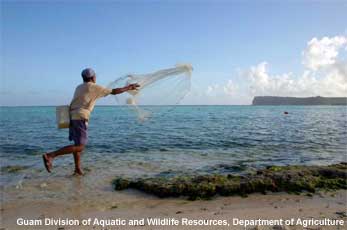How do we fish on coral reefs? |
Traditional fishing methods are used by young and old
 Pacific islanders have many ways to collect the resources that coral reefs provide such as fish, crabs, mollusks, seaweed, urchins, and sea cucumbers. Some of these methods have been passed down from generation to generation. These traditional methods are learned from elders (known locally as kupuna, tuaʻa, or manamko). There are a few traditional methods still in use today such as using cast nets (talaya). It is important that we maintain these practices so that we understand our history with the ocean and coral reefs. As we seek ways to protect coral reefs and other marine resources in the face of climate change, we need think about how both traditional and modern fishing practices may change.
Pacific islanders have many ways to collect the resources that coral reefs provide such as fish, crabs, mollusks, seaweed, urchins, and sea cucumbers. Some of these methods have been passed down from generation to generation. These traditional methods are learned from elders (known locally as kupuna, tuaʻa, or manamko). There are a few traditional methods still in use today such as using cast nets (talaya). It is important that we maintain these practices so that we understand our history with the ocean and coral reefs. As we seek ways to protect coral reefs and other marine resources in the face of climate change, we need think about how both traditional and modern fishing practices may change.
Traditional fishing communities had various ways to regulate the taking of reef plants and animals so that certain species were not over harvested. Having restrictions on fishing during certain spawning seasons was an efficient way to allow fish populations to reproduce. In Hawaii, the konohiki set the rules (kapu) of what fish could be harvested in different seasons. In Samoa, the chief sets the rules on how people were allowed to fish and designated some areas as off limits to fishing. Each ancient Chamorro fishing ground was managed by a clan. Leaders of the clan decided who could harvest fish and when. By making observations of the seasons and other natural events people can tell what animals and plants were ready to be harvested.
How we fish today influences how we will fish in the future
Modern fishing and reef harvesting technology has greatly increased the ease and bounty of taking resources from the sea. For example, scuba fishing and long-lining (trailing miles-long lines with hundreds of hooks through the ocean to catch anything that bites) have allowed greater catches to be taken from the ocean and coral reefs. However, without regulation these modern techniques are not sustainable and have, or soon will, lead to the collapse of some fisheries and the destruction of coral reefs.
In Pacific islands today, there are many people who want to collect food from the reefs. If not done sustainably (with careful consideration of the future of natural resources) fish and other animals may not be able to reproduce, so there will not be enough food in the future, and the food web will not be in balance. To make sure we have fish for now and the future, is often up to the community, county, state, territory, or country to regulate how much can be caught. You can investigate the fishing regulations in Hawaii, American Samoa, and Guam.
We must find new ways or relearn old ways to make sure that we have ocean resources available to us in the future. Traditional techniques may be incorporated into science-based management and the adoption of large-scale sustainable resource management. Complicating management issues are the impacts of climate change, which must be considered when planning for the sustainable future of our natural resources, such as fish. Regardless of the approach, the goal is to keep resources available for generations to come.
| An humanao hao tumalaya, Chuchule’I talaya-mu, Yan kontodu I guagua’-mu, Ya un sisini I kinenne’-mu. — Chamorro song | When you go net-fishing, Take along your net, And also your basket, And fill it with the catch. |






